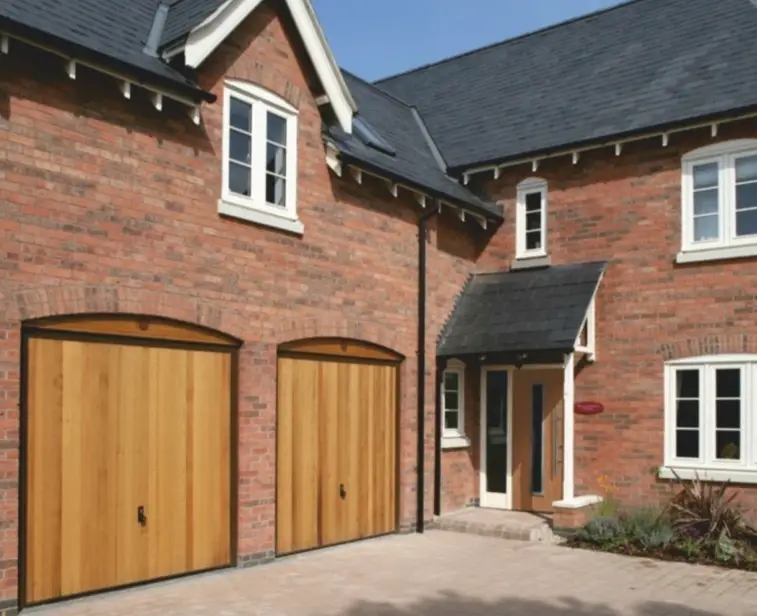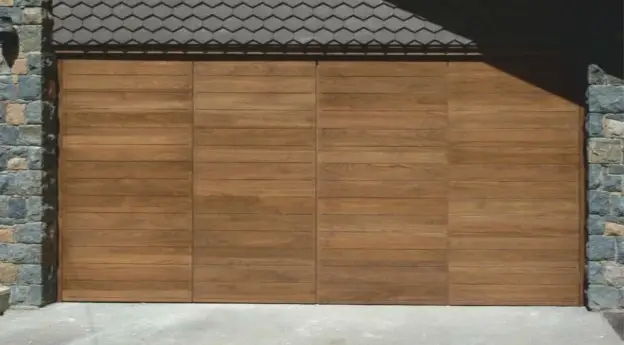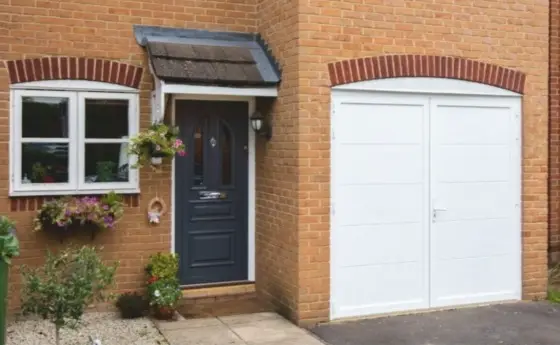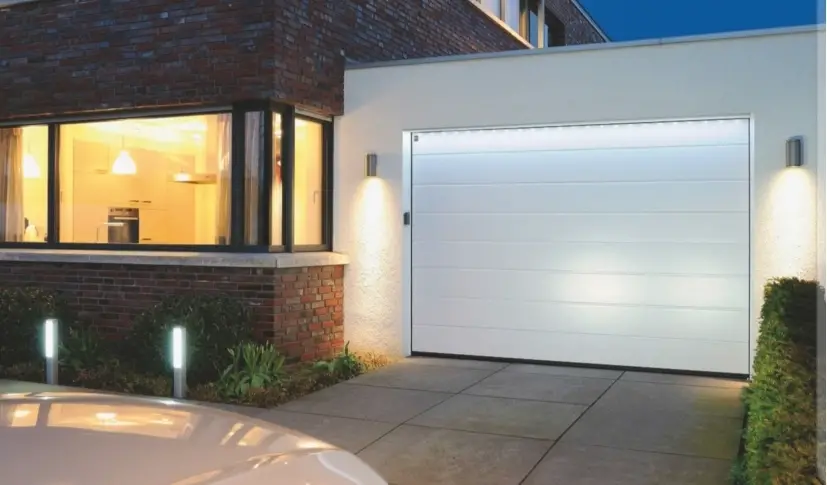The garage door, along with the front door, is a focal point of many homes.
It’s expected to do its job, but its looks are neglected.
A garage door is no small feature, though, and it’s often either part of, or right at the front of the house, so not paying attention to its appearance can compromise a home’s exterior hugely.
Lavish attention on the windows, the front door and exterior walls but neglect the garage door and the overall picture of your home won’t be what you’d hoped.
It’s not just kerb appeal that matters, though.
When there’s a car in there, DIY and garden tools, or even a home gym, a high level of security is vital.
In many circumstances, the insulating properties of the door may also be crucial.
The choice of design can also be important to maximise space internally, and on the driveway outside.
Material decisions
Garage doors can be made from timber, steel, aluminium, glass reinforced plastic (GRP) and PVCu, although not all styles are available in all materials.
Doors made from timber can be sympathetic to older homes, but contemporary-style timber designs are also on offer.
Treatment before installation can reduce maintenance requirements, but do check with the manufacturer/ supplier to be sure of how much work will be needed to keep the particular model sound.
Good quality steel doors are strong and come with a wide choice of surface finishes and color options.
Maintenance requirements depend on the finishing or coating, but aren’t too onerous.
Aluminium is mostly used in insulated double-skin roller doors.
Both colored and timber- look alike effects are available.
The surface will need to be kept clean of grit and debris.
Strong and stable but light, GRP doors are low maintenance, requiring only a regular wash down with running water.
They can have a timber effect, or white or colored finishes.

This up and over canopy garage door with timber infill, stylde 2009 vertical in golden oak, complements the warmth of this home's brick exterior.
Insulating qualities
How you intend to use your garage should influence your decision here.
“Single-skinned doors are ideal for freestanding garages that do not need any thermal insulation, for example when used to store a car,” says David O’Mara, marketing manager at Hörmann.
This is perhaps not the case for integral garages, or those garages used for any other purpose, however.
The style of the door will also make a difference.
“Traditional up-and-over garage doors don’t have the best insulation, letting in draughts and making the space unsuitable for anything other than storing a car, so if you plan to use your garage as a home gym rather than just somewhere to park a car then it is worthwhile doing research into the types of garage doors available,” says David.
Double-skinned sectional doors are one of the best options.
“The double-skinned insulated LPU 67 sectional garage door from Hörmann offers higher levels of thermal insulation, which is ideal if the garage is used as an extra room,” adds David.
Staying secure
A well-fitted garage door with adequate locking is vital because the contents are frequently valuable – whether a car or items such as tools – and also because an integrated garage could provide a way into the house.
Manufacturers supplying doors with the official police security initiative ‘Secured by Design’ accreditation are listed on www.securedbydesign.com.
The initiative is designed to improve the security of our homes and buildings, so choosing an accredited product can bring peace of mind.
Expert fitting of the door is also recommended.
While self-builders can make all the choices with regards to the type and style of garage door, and also prepare the opening for fitting, when it comes to the actual installation it is probably better to rely on a professional.
It’s not so much a DIY job as it’s quite a complex product with lots of components, especially for a roller or sectional garage door, that make it easy to overlook things when fitting if you’re not experienced.
What about costs?
There are automated garage doors illustrated in this article that are upwards of $25,000 (~£20,000), but they are of course top-end examples.
Expect to pay from around $1,050 (~£850) for an up-and-over single garage door in steel (installation will usually be an additional cost); GRP, aluminium roller and timber are generally more costly.
You can find sectional doors starting from around $1,750 (~£1,400) for insulated versions, and roller doors from around $1,625 (~£1,300).
What styles are there?
There’s a surprisingly wide range of garage door options on the market for you to consider.
Up and over
This one-piece design is the classic garage door.
As the name suggests, it lifts up from the bottom, either sliding out of the way below the garage ceiling when open, or creating a canopy at the front.
It’s a sound choice for a garage that’s actually used to park a car in, as it’s space-efficient.
However, enough room is needed to allow it to move forward of the opening as it lifts up and down, so the combination of a short driveway and a car parked waiting to drive into the garage could be an unhappy one.
These doors can be opened manually or automated.
Roller
Like a sectional, a roller door opens vertically, but this design makes a roll above the opening rather than having internal tracks.
They’re suitable for garages without good headroom, when you want to leave the ceiling free
– for storage, perhaps – or where something inside the garage might block other mechanisms.
Both insulated and non-insulated designs are on offer, and they can be teamed with a remote control.
Sectional
Rather than moving outwards like the up and over, a sectional door, made up of vertical panels, moves upwards vertically and then backwards under the garage ceiling to open.
This style of door maximises space both inside the garage and in front of it.
Large versions for big garages are available, and there’s a choice of insulated double-skinned doors, or single-skinned for a garage that doesn’t require insulation.
The design offers a good seal against the weather and can be electrically operated.
Side sliding
If stashing the open garage door in the ceiling isn’t possible, a design that moves round the corner and down the side of the garage on a track is an alternative.
Side sliding doors are useful when you frequently need access to the garage on foot, as you don’t have to open the door all the way to get a bike out, for example.
They work well on large openings and can be automated.
Bifold
Another option when the garage height is an issue, as bifolding doors don’t need wall space for a mechanism.
Whether outward or inward opening, they require sufficient room to fold back.
The panels allow the garage to be accessed without opening the door fully.
A bifold door can also be automated.



This bifold automated garage door has a rich finish in American Black Walnut.
Side hinged
Double doors opening to either side are often traditional in design, so could work for an older home, although contemporary versions can be sleek and modern.
They could have a one-third, two-thirds split or half-and-half across the opening if you prefer.
Although generally opening outwards, there are models that open to the inside, and the slope of your drive could influence the choice.
These doors might be selected where the garage isn’t a home to the car, with one door opening sufficiently wide for on-foot access.
These combine well with a ceiling used for storage as there are no tracks there, but enough driveway space to swing them open is essential.
It’s possible to automate them.



Here's a side-hinged aluminium garage door.

